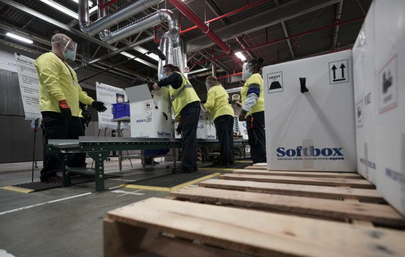Rebuilding operational inventories all along the manufacturing and distribution chain will keep manufacturers and commodity producers exceptionally busy and put upward pressure on prices through at least the end of the year.
In the United States, real consumer spending in the first quarter of 2021 was roughly the same as in the fourth quarter of 2019, the last full three-month period before the first wave of the epidemic arrived.
The unprecedented reprogramming of household spending has depleted stocks held by retailers and wholesalers and left manufacturers unable to keep up with booming orders (tmsnrt.rs/2SRVc55).
Semiconductor shortages have worsened the supply crunch for electrical items, while port congestion and container handling delays have hit merchandise availability more broadly.
As a result, U.S. businesses in manufacturing and distribution held inventories equivalent to just 1.23 months worth of sales in March, down from 1.39 months at the end of 2019, and the lowest ratio for over three decades.
Inventory depletion is most extreme at the retail end of the supply chain, where stocks have fallen to 1.10 months of sales, down from 1.44 at the end of 2019, to a level that has no near parallel in recent decades.
The cyclical swing from destocking at the height of the first wave of the epidemic in March-May 2020 to restocking twelve months later is the most violent inventory cycle since the early 1920s.
Though the most timely and comprehensive data is only available for the United States, the supply chain has also been emptied in much of Europe.
Extreme distortion of the inventory-sales ratio should ease in coming months as economies re-open after the epidemic and households redirect spending back towards services.
Over time, manufacturers and distributors will gradually be able to increase deliveries into the supply chain and rebuild inventories to intended levels.
As merchandise sales ease and inventories rise, the ratio should progressively correct over the remainder of the year and into 2022.
But refilling the supply chain will keep manufacturers, especially in the durables sector, operating near full capacity for at least the next six months, raw materials demand high, and maintain upward pressure on prices.
For the same reason, freight demand and transport costs will remain elevated into next year as manufacturers and distributors try to reposition more merchandise closer to end consumers.
Access the original article here.


